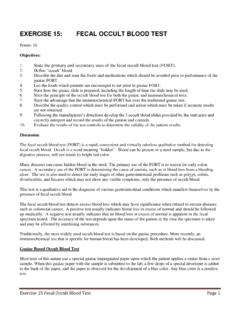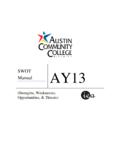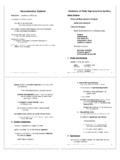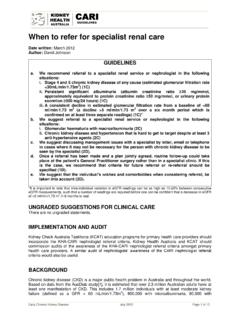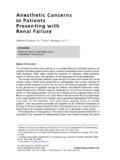Transcription of Anatom y of U rinary System renal - Start Here. Get …
1 Human Anatomy & Physiology: Urinary System ; Ziser Lecture Notes, Urinary SystemUrine production and elimination are one of the mostimportant mechanisms of body homeostasisall body systems are directly or indirectly affected bykidney functioneg. composition of blood is determined more by kidney function than by dietmain function of kidneys is to get rid of metabolicwastes!typically referred to as excretory System excretory wastes = metabolic wastes! chemicals & toxins produced by cells during metabolismGeneral Functions of Urinary System :1. removal of metabolic wastes & toxinsbut we have several organs that serve an excretory functionother than kidneys:1. kidneys2. skinsweat glands rid body of water, minerals,some nitrogenous wastes (ammonia)3. lungsHuman Anatomy & Physiology: Urinary System ; Ziser Lecture Notes, body of CO2 from energy metabolism of cells4. liverliver excretes bile pigments, salts, calcium, some toxins2.
2 Elimination of excess nutrients & excess hormones3. helps to regulate blood volume & pressureblood pressure is directly affected by the volume of fluids retained or removed from body:eg. excessive salts promote water retentiongreater volume ! increases BPeg. dehydrationlower volume ! decreases BP4. regulation of electrolytes & body pH5. regulates erythropoiesiskidneys produce hormone = erythropoietin that regulates erythropoiesis:hypoxic ! secretes more erythropoietinexcessive O2 inhibits hormone production6. aids in calcium absorptionaffects the absorption of Calcium from intestine by helping toactivate Vitamin D circulating in bloodHuman Anatomy & Physiology: Urinary System ; Ziser Lecture Notes, of Urinary SystemOrgans:kidneys clean and filter bloodureters tubes that take urine to bladderbladder stores urine until eliminatedurethra removes urine from body1. kidneysdorsal body wallretroperitoneal !
3 Behind parietal peritoneumjust above waistsurrounded by renal capsule! barrier against trauma and spread ofinfectionshilum = indentation where vessels and ureterattachFrontal Section of Kidneycortexouter zone of kidneymedullainterior of kidneyHuman Anatomy & Physiology: Urinary System ; Ziser Lecture Notes, of the cortex = renal columnsdivides the medulla into 6-10 renalpyramidspapilla of each pyramid nestled in cup shapedcalycescalyces converge to form renal pelvis2. uretersthe rest of urinary System is plumbing renal pelvis funnels urine to paired ureters!tubular extensions of renal pelvisperistalsis moves urine along to bladder3. bladdersmall, size of walnut when emptycan hold up to 800 ml (24 oz) voluntarilyup to 2000 ml (60 oz) when obstructedwall consists of 4 layers (same as GI tract)mucosa -innermost layer secretes mucous for protection fromcorrosive effects of urinesubmucosa -fibrous connective tissueHuman Anatomy & Physiology: Urinary System ; Ziser Lecture Notes, -several smooth muscle layersserosa -visceral peritoneuminvoluntary internal & voluntary external urethral sphinctersas bladder expands to hold urine!
4 Activates stretch receptors in wall thatmonitor volume! when volume exceeds 200 ml the receptor signals enter our conscious perception= desire to urinate4. urethramale:dual function:! rid body of urine! release of seminal fluid during orgasmfemale:single function: rids body of urineshorter! more prone to UTI sHuman Anatomy & Physiology: Urinary System ; Ziser Lecture Notes, of Kidneynephron = functional units of kidneyseach kidney is composed of over 1 million nephronstwo basic parts:1. nephric tubule= microscopic, highly convoluted tubule2. associated blood supplycan find various parts of the nephron and its blood supply in the cortex and medulla of kidneyNephric Tubulethe nephric tubule is organized into several discretestructures:Bowman s Capsulecup shaped mouth of nephronusually in cortexProximal Convoluted Tubuleattached to Bowman s Capsulehighly coiled (convoluted)inner surface contains microvilliLoop of Henlelarge loop consisting of:descending limb & ascending limbextends down into medullaHuman Anatomy & Physiology: Urinary System ; Ziser Lecture Notes, Convoluted Tubuleappears similar to PCTC ollecting Tubulemany DCT s drain into one collecting tubulebundles of collecting tubules = pyramidsPyramids drain into Calyces (sing.)
5 = calyx)Calyces coalesce to form pelvisBlood Supplykidneys are highly vascularizedevery minute, 1200 ml/min of blood flows throughkidneys!=1/5th of cardiac output45 gallons/day; all blood ~60x s/daymore blood perfuses the kidney per weight than anyother organ(much more than eg. brain, heart, liver, etc)within the kidney, bloodflow is greatest in the cortex whereglomeruli are located; flow decreases with depth in themedullaRenal Arterybrings blood to kidneyHuman Anatomy & Physiology: Urinary System ; Ziser Lecture Notes, !branches eventually into afferent arteriolesAfferent Arteriolebring blood to individual nephronsGlomerulusdense capillary bedformed by afferent arterioleinside Bowman s capsuleBowman s Capsule + Glomerulus = renal CorpuscleEfferent Arterioleblood leaves glomerulus via efferent arteriole[! artery!capillary bed! artery]Peritubular Capillariesefferent arteriole divides into another capillary bedsurrounds the rest of the nephric tubule(PCT-LH-DCT-CT) renal Veinreturns blood to vena cavaHuman Anatomy & Physiology: Urinary System ; Ziser Lecture Notes, Physiologyurine formation in nephrons occurs by:1.
6 Filtration2. reabsorption3. secretion1. Filtrationoccurs in renal corpuscle:Glomerulus!Bowmans Capsulewater, salts, small molecules and wastes are filteredout of bloodcapillaries of glomerulus:fenestrated capillaries! act like sievemolecules less than 10,000 MWhave higher filtration pressure than othercapillaries of bodyafferent arteriole is larger than efferent arteriole! increases pressure in glomeruluspressure ~55mmHg(vs 35mmHg in most capillaries)Human Anatomy & Physiology: Urinary System ; Ziser Lecture Notes, can maintain a fairly constant filtration rate! changes in arterial pressure from 80 to 180 mmHg produce little change in blood flow and filtration rate in glomerulusif blood pressure is reduced below this urine formation slows downfiltrate is essentially the same composition as plasma without formed elements or proteinssolutes (filtrate) enter Bowmans capsule2. Tubular Reabsorptionurine is not the same composition as this filtrateComposition of Plasma, Filtrate & Urine(solids in grams/24hrs; water in liters/24 hrs)ReabsorbedPlasmaFiltrateAmount%Urine Proteins 8,000 15 0 Glucose 180 180 0 Salts 1,498 1,498 1,486 12 Water 180 180 178 50 50 25 25 Uric Acid 8 8 0 of the filtrate is reabsorbedoverall, ~99% of glomerular filtrate gets reabsorbed!
7 Only ~1% of original filtrate actually leaves thebody as urine!reabsorption is more selectiveHuman Anatomy & Physiology: Urinary System ; Ziser Lecture Notes, nutrients are conservedwastes and toxins are eliminatedblood levels of fluids, salts, acidity etc are actively regulatedmain metabolic wastes removed by kidneys are nitrogen wastes :1. urea2. uric acid3. creatinine1. ureamain nitrogen containing waste produced during metabolismformed in liver as result of protein breakdownconcentration in urine mainly determined by dietary intake\2. uric acidend product of nucleic acid metabolismsome is also secreted by PCT3. creatininenormal end product of muscle metabolismoccurs all along nephric tubulebut different substances are reabsorbed back into blood from different parts of tubule:Proximal Convoluted Tubule~80% of materials to be reabsorbed are reabsorbed in PCTcells lining PCT havemicrovilliHuman Anatomy & Physiology: Urinary System ; Ziser Lecture Notes, small proteins, glucose, amino acids are reabsorbedmost water, most salts are reabsorbedLoop of Henleadditional Cl+ and Na+ ions are reabsorbed byactive transportunder the control of aldosterone(mineralocorticoids)secretion controlled by saltconcentrations in tissue fluidsalso affects reabsorption of water(water follows salt)Distal Convoluted Tubule & Collecting Tubuleadditional water is reabsorbedunder control of ADH (antidiuretic hormone)No ADH !
8 Tubules are practically impermeable to waterwith ADH ! tubules are permeable towaterHuman Anatomy & Physiology: Urinary System ; Ziser Lecture Notes, Tubular Secretioncells of DCT and CT can also actively secrete some substancesesp K+ and H+ HCO3-NH4some drugs (eg. penecillin)usually urine is slightly acidic! normal diet produces more acid than alkaline waste productsHuman Anatomy & Physiology: Urinary System ; Ziser Lecture Notes, Urine Analysisthe kidneys perform their homeostatic functions ofcontrolling the composition of internal fluids ofbodythe by-product of these activities is Urineurine contains a high concentration of solutesin a healthy person, its volume, pH and soluteconcentration vary with the needs of bodyduring certain pathologies, the characteristics of urinemay change dramaticallyan analysis of urine volume, physical andchemical properties can provide valuableinformation on the internal conditions of thebodyPhysical Characteristicseg.
9 Volumenormal = 1000 1800ml/day ( pints)influenced by:blood pressureblood volumetemperaturediureticsmental stateHuman Anatomy & Physiology: Urinary System ; Ziser Lecture Notes, healtheg. Colornormal = yellow-amber (from hemoglobin breakdown)influenced by:ratio of solutes! >solute darker yellow to brownish! <solute less color to colorlessdiet (eg. beets)blood in urineeg. pHnormal urine is slightly acidic: - by:dieteg. high protein ! acidicvegetables ! alkalinemetabolic disorders:eg. lungs, kidneys, digestive System , etceg. Cells and Castingsnormally find epithelial cells and some bacterial cellsBacteria< 100-1000/ml = contamination by normal flora>100,000/ml = indicates active colonization of urinary systemRBC s & WBC spresence is almost always pathologicalinflammation of urinary organsHuman Anatomy & Physiology: Urinary System ; Ziser Lecture Notes, from infectionsChemical Characteristicseg.
10 Proteinsnormally too large to filter outpresence indicates increased permeability of glomerularmembrane due to:injuryhigh blood pressureirritationtoxinseg. glucosenormally, all is filtered and all reabsorbedbody reabsorbs as much as is neededwhen it appears in urine indicates high blood sugarconcentrations! symptom of diabetes mellitiseg. ketonesproduced when excessive quantities of fats arebeing catabolizedhigh quantities may be caused by:diabetesstarvationdieting!too little carbohydrates in dietHuman Anatomy & Physiology: Urinary System ; Ziser Lecture Notes, The Aging Urinary Systemkidneys show lots of atrophy in old age! from ages 25 to 85; number of nephronsdeclines by 30 40%! up to 1/3rd of remaining glomeruli becomeatherosclerotic, bloodless and nonfunctionalkidneys of 90 yr old man are 20 40% smaller thanthose of a 30 yr old and receive only half as muchbloodproportionately less efficient at clearing wastes!


